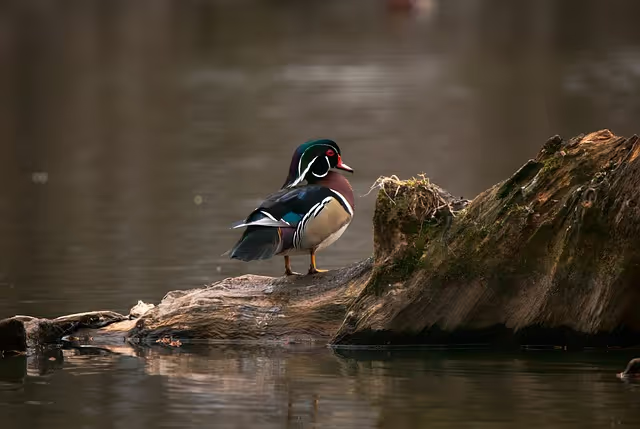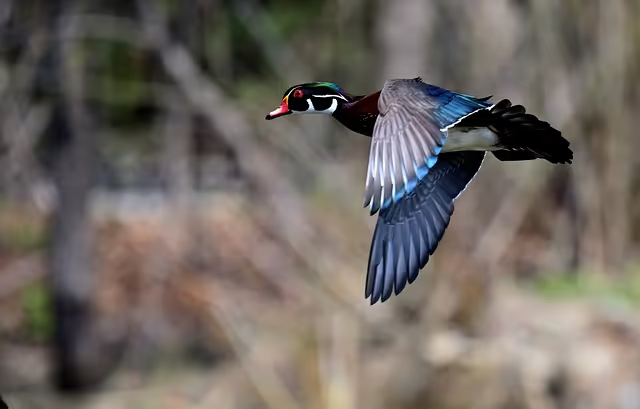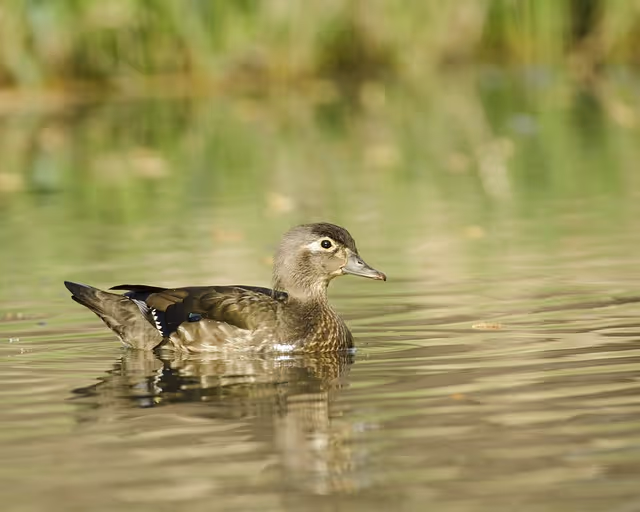Wood Ducks


Introduction
Earlier this fall, I was playing tourist in Olympia, and visited the McLane Creek Nature Trail in the Capitol State Forest. It is a beautiful site with an abundance of trees and wildlife located just minutes outside of the hustle and bustle of the big city. One of McLane Creek’s most notable features is a large beaver pond, with viewing points located just a few hundred feet from the trailhead’s parking lot. On the day I visited, the beaver pond was full of ducks. They were everywhere, swimming in the water, dabbling for food, napping in the pond’s grassy areas, and otherwise having a good time. Most of the ducks I saw were mallards. However, there was one duck off by itself that didn’t look quite like a mallard. It appeared to have a more decorated color scheme, with streaks of white on its head. Mallards don’t have any streaks on their heads (4). Since then, it has been on the back of my mind to try and identify which species of duck I was looking at. Recently, it hit me that the duck I had been looking at was none other than a Wood Duck.

Image by MICHELLE HN from Pixabay
Appearance
Wood Ducks (Aix sponsa) are some of the most well decorated birds that you can find in the Pacific Northwest. Male Wood Ducks stand out particularly, with green heads that appear glossy when viewed in good lighting conditions (2). Their heads have streaks of white cutting across them (2), which add to their bold appearance. Male Wood Ducks also have chestnut-colored breasts, “buffy” sides, and bright red eyes (2). In low or harsh lighting conditions, these features won’t stand out as much. The ducks will appear to be darker and more pale (2). Additionally, in late summer, male Wood Ducks sport eclipse plumage. During this time, they lose their white streaks and pale sides (2).
Female and juvenile Wood Ducks don’t have quite as striking of an appearance as male Wood Ducks, but they still look quite elegant. They are gray to brown in color, with white-speckled breasts and a hint of yellow around their eyes (2).
Shape and Size
Another feature that makes Wood Ducks stand out from other duck species is their shape. They have long bodies, crested and “boxy” heads, short wings, and long, broad tails, and thin necks (2). When they are in flight, they hold their heads up high, sometimes bobbing them about (2).
Wood Ducks are fairly large birds. They aren’t as big as geese, but are larger than crows (2). Both males and females weigh anywhere from 16 to 34 ounces (454 to 862 grams) and have a wingspan of 26 to 28.7 inches (66 to 73 centimeters) (2). They are 18.5 to 21.3 inches (47 to 54 centimeters) long (2).

Image by simardfrancois from Pixabay
Habitat
Wood Ducks make their homes in wooded swamps, shallow inland lakes, ponds, and slow-moving rivers (1). They prefer environments that are surrounded by deciduous or mixed woodland. They especially like places where large trees extend out over the water, creating shady conditions (1). Wood Ducks will also make their homes in open marshes that are located within areas that are otherwise forested (1).
Diet and Feeding Behavior
Wood Ducks primary eat seeds and acorns. They will also feed on aquatic plants, waste grain, crustaceans, and insects (1). Juvenile Wood Ducks mostly limit their diet to invertebrates and insects (1).
Wood Ducks mostly forage in the water for their food. They will take food directly from the surface, submerging only their head and neck. They will occasionally up-end (dabble) (1). Wood Ducks also forage for food on land from time-to-time (1).
Behavior
Unlike most waterfowl, Wood Ducks enjoy perching in trees and flying through wooded areas (2). Their shorter wingspans and broader tails help them to maneuver around obstacles with ease. When they are swimming, their heads will move back and forth in a jerking manner that resembles the motions pigeons make when they walk (2). Wood Ducks value their privacy, and prefer being in small groups that are away from other waterfowl (2).

Image by Robin Arnold from Pixabay
Courtship and Nesting
At the start of each breeding cycle, which normally occurs sometime between January and April (5), males will attract females by taking on “postures” that display their colorful plumage (1). Once bonded pairs have formed, nest sites are chosen. Wood Ducks prefer large tree cavities that are located near water or artificial nest boxes (1). The nest is normally no higher than 65 feet off the ground (1). It is lined with wood chips and down to keep it warm and comfortable (1, 5).
Eggs and the Young
Wood Ducks lay anywhere from 6 to 16 eggs per breeding cycle (1), laying one egg per day (5). Unlike with most animal species, not all of the eggs that are laid will necessarily be laid in the nest that the bonded pair is using. Wood Ducks regularly partake in a practice that is known as “egg dumping” (5). This is when females lay some of their eggs in the nests of other bonded pairs (5). This leads to the formation of large clutches that can grow to hold as many as 40 eggs (5). It is believed that this unusual practice is an adaptation the species has made to maximize its chances of survival (5).
The incubation process is handled exclusively by the female, and takes anywhere from 25 to 35 days (1). During this time, the male will remain present near the nesting site to protect the female and the unhatched eggs, before leaving to molt (5). Once the eggs hatch, the ducklings will remain in the nest until the following morning (1). They will then exit the nesting site and jump onto the ground (1). The ducklings can jump from heights exceeding 50 feet without injuring themselves (3). The female tends to the ducklings for up to 10 weeks before the young gain their independence (5). The ducklings are capable of flight after approximately 8 to 9 weeks of age (1).
Wood Ducks breed once or twice per year, depending on where they are located (1). In Southern Canada, Atlantic Canada, and the northern regions of the United States, they will only breed once per year (1). In Mexico and the southern regions of the United States, it is common for Wood Ducks to breed twice per year (1).
References
© Ian Caldwell, November 2023
Touch whale bones, examine shipwreck artifacts and connect with the coast's living history.

Support our mission, get involved in educational programs, or contribute through donations and volunteering.